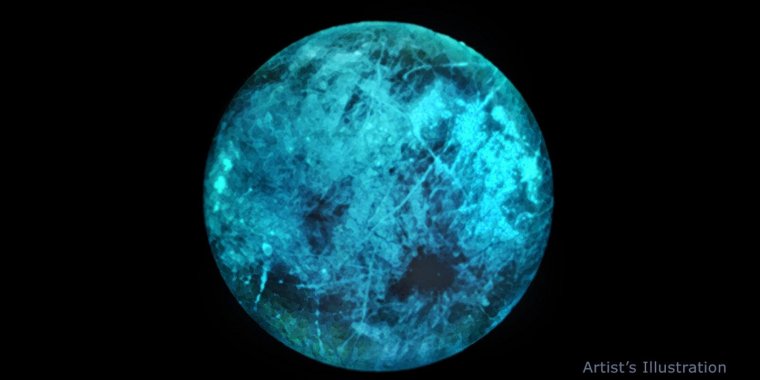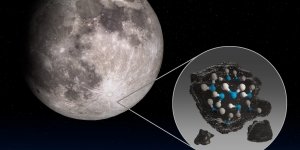| News / Space News |
Europa Glows: Radiation Does a Bright Number on Jupiter's Moon
New lab experiments re-create the environment of Europa and find that the icy moon shines, even on its nightside. The effect is more than just a cool visual. As the icy, ocean-filled moon Europa orbits Jupiter, it withstands a relentless pummeling of radiation. Jupiter zaps Europa's surface night and day with electrons and other particles, bathing it in high-energy radiation. But as these particles pound the moon's surface, they may also be doing something otherworldly: making Europa glow in the dark.

This illustration of Jupiter's moon Europa shows how the icy surface may glow on its nightside, the side facing away from the Sun. Variations in the glow and the color of the glow itself could reveal information about the composition of ice on Europa's surface. Image credit: NASA/JPL-Caltech
New research from scientists at NASA's Jet Propulsion Laboratory in Southern California details for the first time what the glow would look like, and what it could reveal about the composition of ice on Europa's surface.
Different salty compounds react differently to the radiation and emit their own unique glimmer. To the naked eye, this glow would look sometimes slightly green, sometimes slightly blue or white and with varying degrees of brightness, depending on what material it is.
Scientists use a spectrometer to separate the light into wavelengths and connect the distinct "signatures," or spectra, to different compositions of ice. Most observations using a spectrometer on a moon like Europa are taken using reflected sunlight on the moon's dayside, but these new results illuminate what Europa would look like in the dark.
That's because Europa holds a massive, global interior ocean that could percolate to the surface through the moon's thick crust of ice. By analyzing the surface, scientists can learn more about what lies beneath.
Scientists have inferred from prior observations that Europa's surface could be made of a mix of ice and commonly known salts on Earth, such as magnesium sulfate (Epsom salt) and sodium chloride (table salt).
The new research shows that incorporating those salts into water ice under Europa-like conditions and blasting it with radiation produces a glow.
That much was not a surprise. It's easy to imagine an irradiated surface glowing. Scientists know the shine is caused by energetic electrons penetrating the surface, energizing the molecules underneath. When those molecules relax, they release energy as visible light.
A moon that's visible in a dark sky may not seem unusual; we see our own Moon because it reflects sunlight. But Europa's glow is caused by an entirely different mechanism, the scientists said. Imagine a moon that glows continuously, even on its nightside - the side facing away from the Sun. (NASA)
YOU MAY ALSO LIKE





